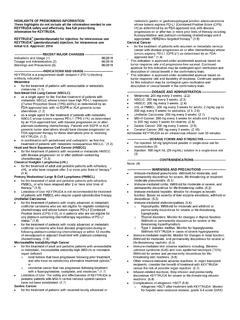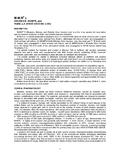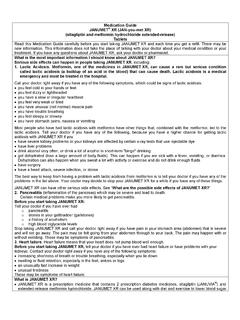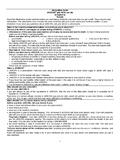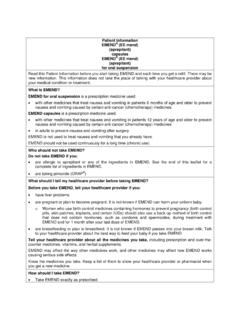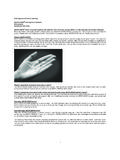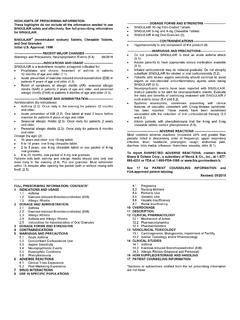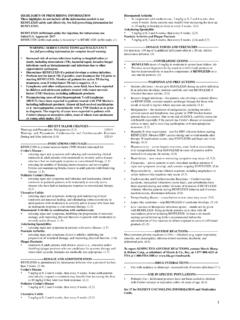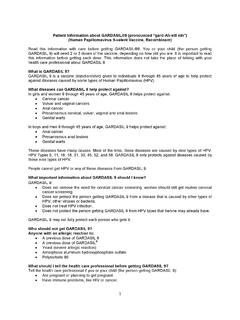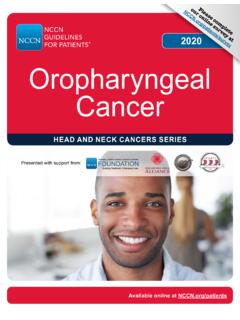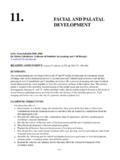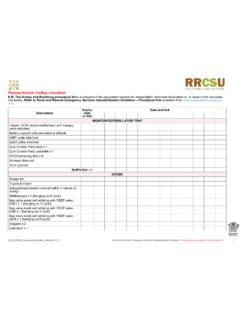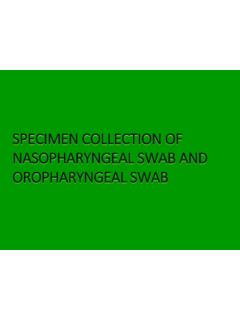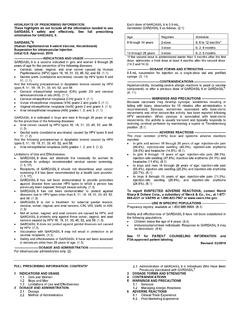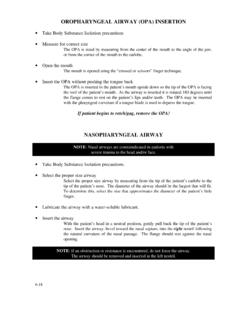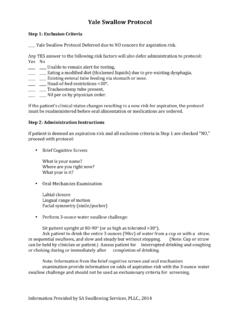Transcription of HIGHLIGHTS OF PRESCRIBING INFORMATION NOXAFIL. …
1 1 HIGHLIGHTS OF PRESCRIBING INFORMATIONT hese HIGHLIGHTS do not include all the INFORMATION needed to useNOXAFIL safely and effectively. See full PRESCRIBING INFORMATION (posaconazole) injection, for intravenous use NOXAFIL (posaconazole) delayed-release tablets, for oral use NOXAFIL (posaconazole) oral suspension NOXAFIL PowderMix (posaconazole) for delayed-release oralsuspensionInitial Approval: 2006 --------------------------- RECENT MAJOR CHANGES --------------------------- Indications and Usage (1) 6/2021 Dosage and Administration (2) 6/2021 Contraindications (4) 1/202 2 Warnings and Precautions (5) 1/202 2 ----------------------------INDICATIONS AND USAGE ---------------------------- Noxafil is a n azole antifungal indicated as follows: Noxafil injection and Noxafil delayed-release tablets are indicatedfor the treatment of invasive aspergillosis in adults and pediatricpatients 13 years of age and older.
2 ( ) Noxafil is indicated for the prophylaxis of invasive Aspergillus andCandida infections in patients who are at high risk of developing theseinfections due to being severely immunocompromised, such ashematopoietic stem cell transplant (HSCT) recipients with graft -versus-host disease (GVHD) or those with hematologic malignancieswith prolonged neutropenia from chemotherapy as follows: (1. 2)o Noxafil injection: adults and pediatric patients 2 years of age andoldero Noxafil delayed-release tablets: adults and ped iatric patients 2years of age and older who weigh greater than 40 kgo Noxafil oral suspension: adults and pediatric patients 13 yearsof age and oldero Noxafil PowderMix for delayed-release oral suspension:pediatric patients 2 years of age and older who weigh 40 kg orless Noxafil oral suspension is indicated for the treatment oforopharyngeal candidiasis (OPC), including OPC refractory (rOPC) toitraconazole and/or fluconazole in adult and pediatric patients aged13 years and older.
3 (1. 3) ----------------------- DOSAGE AND ADMINISTRATION ----------------------- Noxafil oral suspension is not substitutable with Noxafil delayed-release tablets or Noxafil PowderMix for delayed-release oralsuspension due to the differences in the dosing of each , follow the specific dosage recommendations for each ofthe formulations. ( , , , 2. 8) Noxafil injection must be administered through an in-line filter. Administer Noxafil injection by intravenous infusion overapproximately 90 minutes via a central venous line. ( ) Do NOT administer Noxafil injection as an intravenous bolusinjection. ( ) Administer Noxafil delayed-release tablets with or without food.( ) Administer Noxafil oral suspension with a full meal. ( ) Administer Noxafil PowderMix for delayed-release oralsuspension with food. ( ) Administer Noxafil PowderMix for delayed-release oralsuspension with the provided notched tip syringes only.
4 ( )Table 1: Recommended Dosage in Adult PatientsIndication Dosage Form, Dose, and Duration ofTherapyTreatment of invasive Aspergillosis Noxafil Injection:Loading dose:300 mg Noxafil injection intravenously twice aday on the first dose: 300 mg Noxafil injection intravenously once aday thereafter. Recommended total durationof therapy is 6 to 12 weeks. ( )Noxafil Delayed-Release Tablets: Loading dose: 300 mg ( three 100 mgdelayed-release tablets) twice a day on thefirst day. Maintenance dose: 300 mg (three 100 mgdelayed-release tablets) once a daythereafter. Recommended total duration oftherapy is 6 to 12 weeks. ( )Switching between the intravenous anddelayed-release tablets is acceptable. Aloading dose is not required when switchingbetween formulations. ( )Prophylaxis of invasive Aspergillus and Candida infections Noxafil Injection: Loading dose: 300 mg Noxafil injectionintravenously twice a day on the first dose: 300 mg Noxafil injectionintravenously once a day thereafter.
5 Durationof therapy is based on recovery fromneutropenia or immunosuppression. ( , )Noxafil Delayed-Release Tablets: Loading dose: 300 mg (three 100 mgdelayed-release tablets) twice a day on thefirst day. Maintenance dose: 300 mg (three 100 mgdelayed-release tablets) once a day, startingon the second day. Duration of therapy isbased on recovery from neutropenia orimmunosuppression. ( , )Noxafil Oral Suspension: 200 mg (5 mL)three times a day. Duration of therapy isbased on recovery from neutropenia orimmunosuppression. ( , ) oropharyngeal Candidiasis (OPC) Noxafil Oral Suspension: Loading dose: 100 mg ( mL) twice a dayon the first day. Maintenance dose: 100 mg ( mL) once aday for 13 days. ( , )OPC Refractory (rOPC) to Itraconazole and/or FluconazoleNoxafil Oral Suspension: 400 mg (10 mL)twice a day. Duration of therapy is based onthe severity of the patient s underlyingdisease and clinical response.
6 ( , ) For pediatric patients, see the Full PRESCRIBING INFORMATION for dosingrecommendations for Noxafil injection, Noxafil delayed-releasetablets, Noxafil oral suspension, and Noxafil PowderMix fordelayed-release oral suspension based on the age and indicationassociated with the dosage form. ( , , 1 .3, , ) --------------------- DOSAGE FORMS AND STRENGTHS --------------------- Noxafil injection: 300 mg per vial (18 mg per mL) in a single dose vial(3) Noxafil delayed-release tablet: 100 mg (3) Noxafil oral suspension: 40 mg per mL (3) Noxafil PowderMix for delayed-release oral suspension: 300 mg (3) ------------------------------- CONTRAINDICATIONS ------------------------------- Known hypersensitivity to posaconazole or other azole antifungalagents. ( ) Coadministration of Noxafil with the following drugs iscontraindicated; Noxafil increases concentrations and toxicities of: Sirolimus ( , , ) CYP3A4 substrates (pimozide, quinidine): can result in QTcinterval prolongation and cases of torsades de pointes (TdP )( , , ) HMG-CoA Reductase Inhibitors Primarily Metabolizedthrough CYP3A4 ( , ) Ergot alkaloids ( , ) Venetoclax: In patients with chronic lymphocytic leukemia(CLL) or small lymphocytic lymphoma (SLL ) at initiation andduring the ramp-up phase ( , , ) 2 Noxafil PowderMix for delayed-release oral suspension iscontraindicated in patients with known or suspected HereditaryFructose Intolerance (HFI).
7 (4. 7, , ) ----------------------- WARNINGS AND PRECAUTIONS ------------------------ Calcineurin-Inhibitor Toxicity: Noxafil increases concentrations ofcyclosporine or tacrolimus; reduce dose of cyclosporine andtacrolimus and monitor concentrations frequently. ( ) Arrhythmias and QTc Prolongation: Noxafil has been shown toprolong the QTc interval and cause cases of TdP. Ad minister withcaution to patients with potentially proarrhythmic conditions. Do notadminister with drugs known to prolong QTc interval and metabolizedthrough CYP3A4. ( ) Electrolyte Disturbances: Monitor and correct, especially thoseinvolving potassium (K+), magnesium (Mg++), and calcium (Ca++),before and during Noxafil therapy. ( ) Hepatic Toxicity: Elevations in liver tests may occur. Discontinuationshould be considered in patients who develop abnormal liver tests ormonitor liver tests during treatment.
8 ( ) Renal Impairment: Noxafil injection should be avoided in patients withmoderate or severe renal impairment (creatinine clearance <50mL/min), unless an assessment of the benefit/risk to the patientjustifies the use of Noxafil injection. (5. 5, ) Concomitant Use with Midazolam: Noxafil can prolonghypnotic/sedative effects. Monitor patients and benzodiazepinereceptor antagonists should be available. ( , ) Vincristine Toxicity: Concomitant administration of azole antifungals,including Noxafil, with vincristine has been associated withneurotoxicity and other serious adverse reactions; reserve azoleantifungals, including Noxafil, for patients receiving a vinca alkaloid,including vincristine, who have no alternative antifungal treatmentoptions. ( , ) Risk in Patients with Hereditary Fructose Intolerance (HFI): NoxafilPowderMix for delayed-release oral suspension contains of metabolic crisis with life -threatening hypoglycemia,hypophosphatemia, lactic acidosis, and hepatic failure.
9 Obtainhistory of HFI symptoms in pediatric patients before NoxafilPowderMix for delayed-release oral suspension administration. ( , ) Breakthrough Fungal Infections: Monitor patients with severediarrhea or vomiting when receiving Noxafil delayed-release tablets,Noxafil oral suspension, and Noxafil PowderMix for delayed-releaseoral suspension. ( ) Venetoclax Toxicity: Concomitant administration of Noxafil withvenetoclax may increase venetoclax toxicities, including the risk oftumor lysis syndrome, neutropenia, and serious infections; monitor fortoxicity and reduce venetoclax dose. ( , , ) ------------------------------ ADVERSE REACTIONS ------------------------------ Adult Patients: Common adverse reactions in studies with Noxafil inadults are diarrhea, nausea, fever, vomiting, headache, coughing,and hypokalemia. (6. 1) Pediatric Patients: Common adverse reactions (incidence >20%receiving 6 mg/kg Noxafil injection and Noxafil PowderMix fordelayed-release oral suspension) in a stud y in pediatric patients arepyrexia, febrile neutropenia, vomiting, mucosal inflammation, pruritus,hypertension, hypokalemia, and stomatitis.
10 ( ) To report SUSPECTED ADVERSE REACTIONS, contact MerckSharp & Dohme Corp., a subsidiary of Merck & Co., Inc., at 1-877 -888 -4231 or FDA at 1-800 -FDA-1088 or . ------------------------------- DRUG INTERACTIONS ------------------------------- Interaction Drug InteractionRifabutin, phenytoin, efavirenz, cimetidine, esomeprazole* Avoid coadministration unlessthe benefit outweighs the risks( , , , )Other drugs metabolized by CYP3A4 Consider dosage adjustmentand monitor for adverse effectsand toxicity ( , , )Digoxin Monitor digoxin plasmaconcentrations ( )Fosamprenavir, metoclopramide* Monitor for breakthrough fungalinfections ( , )*The drug interactions with esomeprazole and metoclopramide donot apply to Noxafil tablets. ----------------------- USE IN SPECIFIC POPULATIONS ----------------------- Pregnancy: Based on animal data, may cause fetal harm. ( ) Pediatrics: Safety and effectiveness in patients younger than 2 yearsof age have not been established.
